A Place for Everything
By: Sarah Stebbins
Photography: Francois Gagne
FEATURE
A historic, midcoast home, reimagined for a couple and their collections
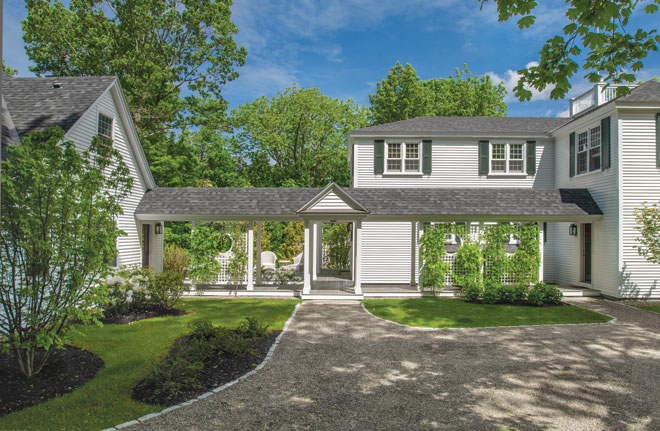
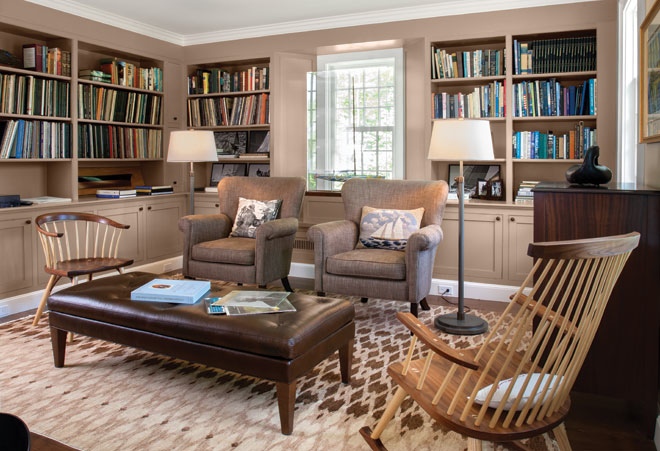
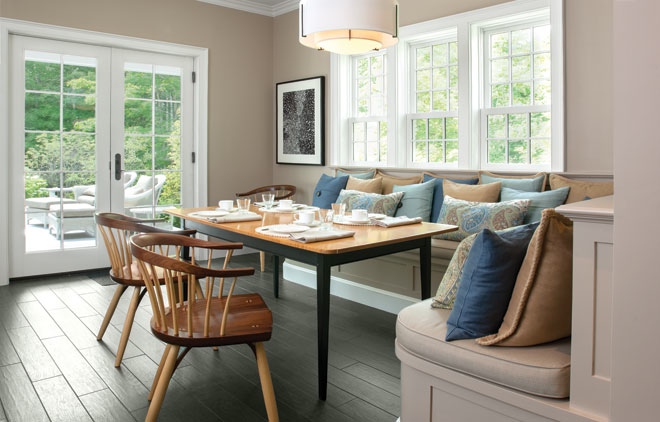
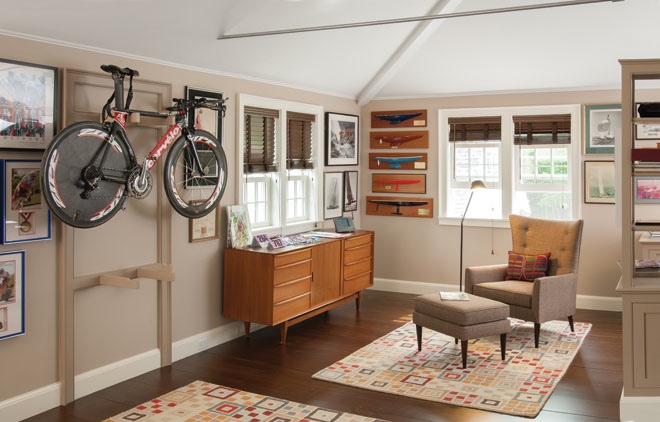
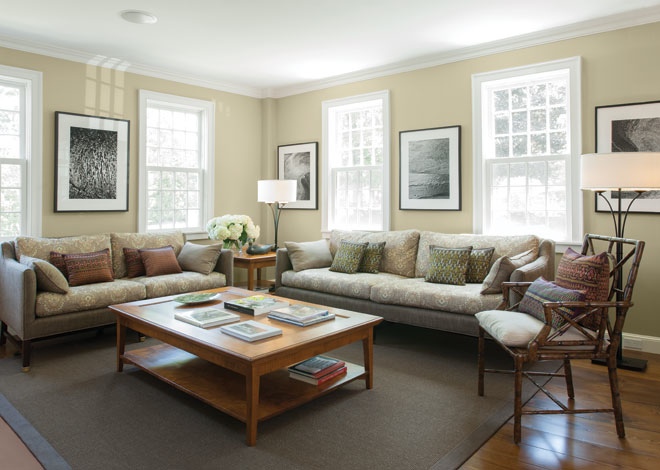
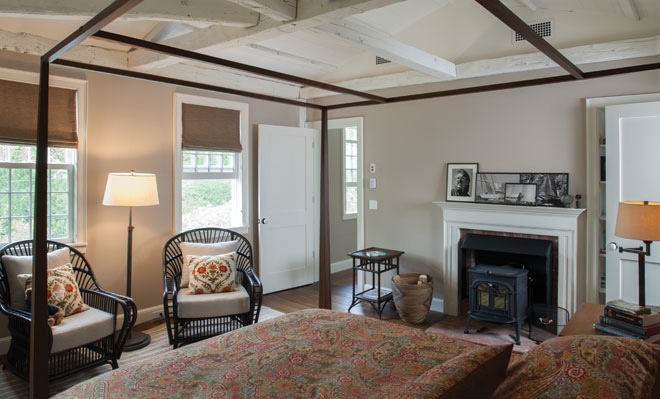
In the elegant Colonial architects Stephen and Justin Smith rehabbed in Camden, a shelf is not merely a shelf. It is a lighted platform designed for antique wooden decoys, their puffed-up chests turned this way and that, like they’re drifting in different directions. It’s a ledge spec’d for square album covers and reinforced with steel rods to hold a weighty vinyl collection. Or a perch for stemware, precisely sized to accommodate the homeowners’ tallest Bordeaux glasses.
“This was a client who knew exactly how many square feet of space he needed for every important item or collection,” says Stephen of the husband, who purchased the home with his wife in 2010. The purpose of each set of shelves is noted in the architects’ plans, along with the placement of a prized America’s Cup yacht model encased in glass, an intricately carved walnut gun cabinet imported from England, and the husband’s road and racing bikes, which hang on a wall upstairs.
Both of the homeowners have a marine background: she is a former professional yacht photographer and he sailed competitively in America’s Cup races and the Olympics, winning a bronze medal at age 30. He worked in the sail-making and boatbuilding industries before becoming a manager for the America’s Cup program. “In the boating world space is precious and you’re always thinking about how to use it economically,” says the husband. “Applying that logic to a house makes it more livable—you don’t run out of room for the things you need or care about or find yourself with five feet of extra shelving that could have been used for something else.”
The couple searched for three years before they found their 1803 Federal-style home, built, appropriately enough, by a blacksmith who made fittings for ships. Ensconced behind a wall of overgrown shrubs, the place had a shabby, dated interior and plenty of quirks, like a narrow, steep front staircase that was as tricky to navigate as a ship’s ladder. “We weren’t looking for a project, but knew it was probably inevitable if we wanted to end up with something that felt like our own,” says the husband. “We wouldn’t have been happy living in someone else’s dream.”
The building consisted of the original four-room home (two living rooms on the first floor with bedrooms above) and a pair of rear additions likely put on in the 1870s and early 1900s. As you moved from front to back, the structure became less stable: the middle section was severely under-framed and the kitchen and mudroom were sagging atop stone and wood posts. Given the varying conditions, the architects recommended a three-pronged approach: restore the oldest end of the home, with the floor plan intact; shore up the central core; and completely rebuild the kitchen wing. The team, which included Keith Daggett of Heritage Builders in Rockport, also added a graceful breezeway connecting the new mudroom to the former barn, now a refurbished garage and guesthouse.
Daggett’s work turned into an excavation of sorts. “We never knew what we were going to find,” says the builder, whose crew uncovered the original deed to the property in a closet and, in the master bedroom, laid bare a lofty post-and-beam ceiling that the homeowners decided to whitewash and leave exposed. While dismantling the damaged plaster walls, he discovered that the masonry for the four original fireplaces, which share a chimney, formed a soaring pointed arch. There was just enough room between the bricks to squeeze in a staircase, creating a dramatic ascent and a replacement for the precarious old steps. To make space for a landing at the base of the stairs, the architects created a vestibule with the door, sidelights, and pilasters from the original entrance.
The homeowners kept the scale of the new rooms in line with the old—“nothing voluminous or double-height,” says the wife—and shuffled the layout to suit their needs. The second floor features his-and-hers dressing rooms and bathrooms and an office-workout space for the husband, who rides his bikes indoors (on a stand) and out. Downstairs, the wife, who is Italian, wanted an enclosed kitchen and dining room with a pantry between them, as is common in European homes. “There are a lot of open kitchens in America, but when you set a nice table for guests, I don’t think you want to see the dirty pots,” she says.
Instead, guests seated at the walnut dining table can contemplate a pair of black-and-white photographs, taken by the wife, that depict spray on the surface of a brook. The blurred drops, captured in various stages of mottled white and shadowy gray like phases of the moon, appear to spatter the frame’s glass and extend infinitely into the inky backdrop. More of the wife’s black-and-white water images are on display throughout the house; her color prints are in the guest quarters above the garage. “I like the photos to form a continuum,” she says.
You can see the artist’s hand at work in the mix of furnishings, which the wife collaborated on with Marcy and Megan van der Kieft of Margo Moore Interiors in Camden. Like the photos, the design is confined to a neutral palette, but there’s plenty of energy. In the library, the lattice pattern and gradation of browns in a David Easton rug plays off Thos. Moser’s delicately spindled Newport chair and New Gloucester rocker, rendered in dark walnut and pale ash. And in the living room, taupe linen sofas with paisley cushions from Lee Jofa are juxtaposed with a painted wood Hickory Chair, hand-carved to resemble bamboo, and silk pillows with an intricate, far-eastern motif. A golden tiger maple coffee table, custom-made by Windsor Chairmakers in Lincolnville, practically glows amid the muted shades. “This client has a fabulous eye and she dictated the modern-classic shapes and calming colorations—everything really flows,” says Marcy.
All the walls on the first floor are painted a version of Benjamin Moore’s Alexandria Beige, a color the wife says looks “light in the summer and warm and cozy in the winter.” The rooms upstairs are a few shades paler (California Paints’ Steveareno Beige), creating a natural balance—like the way sun hits a mountaintop and leaves the base in shadow. The shelves are painted to match the wall color, rather than the trim, so that they “disappear,” says the wife. “We wanted to put the emphasis on our collections.”
The husband, an avid duck hunter, has been amassing wooden decoys for more than 40 years. His compilation is comprised of birds in their original working condition, made by master craftsmen in Connecticut and Maine in the nineteenth and early twentieth centuries. The Connecticut models are lighter, smaller, and more delicate than those from Maine—a reflection of the harsher hunting conditions in these parts. “I’m fascinated by the interaction between practicality and art,” says the husband. “Things like decoys, bicycles, and wine glasses don’t have to be beautiful but when they are I like to display them.”
The finely shaped glasses, crafted from crystal and arranged in paned cabinets in the pantry, are a companion to one more of the homeowners’ collections: a cache of wine from virtually every major growing region in the world. Tucked away in a fragrant, cedar-lined cellar are rows of metal racks with space for up to 3,714 regular, half, and magnum bottles—a figure the husband arrived at by averaging the number of bottles he and his wife uncork per year and multiplying by ten to ensure there are always wines ready to drink while others are aging. “This was the most exactly designed area of the house,” he says. “And it has pretty close to exactly worked.”
